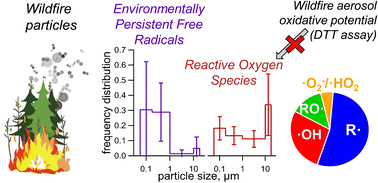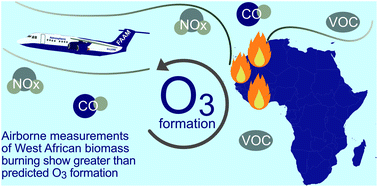Themed collection Wildfire impacts on atmospheric composition - Topic Highlight

Performance of Vehicle Add-on Mobile Monitoring System PM2.5 measurements during wildland fire episodes
A universally attachable, lightweight PM2.5 mobile monitor provides reliable and actionable supplemental information on air quality conditions in communities impacted by wildland fire smoke via a nationwide loan program.

Environ. Sci.: Atmos., 2024,4, 306-320
https://doi.org/10.1039/D3EA00170A
Wavelength-resolved quantum yields for vanillin photochemistry: self-reaction and ionic-strength implications for wildfire brown carbon lifetime
Photochemistry of multifunctional aromatics like vanillin can depend strongly on wavelength, initial concentration, and ionic strength. Using several narrow-band LEDs we present wavelength resolved quantum yields for loss of vanillin.

Environ. Sci.: Atmos., 2024, Advance Article
https://doi.org/10.1039/D4EA00002A
Insights into Pyrocumulus aerosol composition: black carbon content and organic vapor condensation
Megafires are increasingly generating Pyrocumulus clouds (PyroCus) through the interplay of atmospheric conditions such as stability and humidity, hot updrafts, and emitted aerosols from burning vegetation.

Environ. Sci.: Atmos., 2024,4, 80-87
https://doi.org/10.1039/D3EA00130J
Assessing formic and acetic acid emissions and chemistry in western U.S. wildfire smoke: implications for atmospheric modeling
Rapid production of formic acid in biomass burning smoke is not captured by the Master Chemical Mechanism (MCM) nor simplified GEOS-Chem chemistry, likely due to missing secondary chemical production.

Environ. Sci.: Atmos., 2023,3, 1620-1641
https://doi.org/10.1039/D3EA00098B
Molecular and physical composition of tar balls in wildfire smoke: an investigation with complementary ionisation methods and 15-Tesla FT-ICR mass spectrometry
Laser desorption ionisation, coupled with ultrahigh-resolution mass spectrometry, provides an apt reflection of the physical properties of tar balls in wildfire smoke.

Environ. Sci.: Atmos., 2023,3, 1552-1562
https://doi.org/10.1039/D3EA00085K
A national crowdsourced network of low-cost fine particulate matter and aerosol optical depth monitors: results from the 2021 wildfire season in the United States
A novel instrument designed for crowdsourced data collection on air quality and aerosol optical depth.

Environ. Sci.: Atmos., 2023,3, 1563-1575
https://doi.org/10.1039/D3EA00086A
Case study evaluation of size-resolved molecular composition and phase state of carbonaceous particles in wildfire influenced smoke from the Pacific Northwest
Wildfires are significant sources of carbonaceous particles in the atmosphere.

Environ. Sci.: Atmos., 2023,3, 1251-1261
https://doi.org/10.1039/D3EA00058C
Brown carbon absorptivity in fresh wildfire smoke: associations with volatility and chemical compound groups
Brown carbon light absorptivity is associated with organic aerosol volatility and elemental carbon concentrations.

Environ. Sci.: Atmos., 2023,3, 1262-1271
https://doi.org/10.1039/D3EA00067B
Optical properties of biomass burning aerosol during the 2021 Oregon fire season: comparison between wild and prescribed fires
The Mt. Bachelor Observatory was frequently impacted by biomass burning smoke in 2021, an extreme forest fire year in the state of Oregon.

Environ. Sci.: Atmos., 2023,3, 608-626
https://doi.org/10.1039/D2EA00118G
Wildfire particulate matter as a source of environmentally persistent free radicals and reactive oxygen species
Wildfire particulate matter contains high amounts of environmentally persistent free radicals and generates reactive oxygen species with implications for air quality and public health.

Environ. Sci.: Atmos., 2023,3, 581-594
https://doi.org/10.1039/D2EA00170E
Atmospheric OH reactivity in the western United States determined from comprehensive gas-phase measurements during WE-CAN
Using OH reactivity we assess the major daytime OH radical sinks in western U.S. wildfire plumes and other smoke impacted environments, testing their current model representation while providing a roadmap for future model development.

Environ. Sci.: Atmos., 2023,3, 97-114
https://doi.org/10.1039/D2EA00063F
Furoyl peroxynitrate (fur-PAN), a product of VOC–NOx photochemistry from biomass burning emissions: photochemical synthesis, calibration, chemical characterization, and first atmospheric observations
Wildfires produce furan compounds that are involved in atmospheric oxidant and SOA formation. One such compound, furfural, produces furoyl peroxynitrate (fur-PAN) in the atmosphere, a unique marker for this wildfire chemistry.

Environ. Sci.: Atmos., 2022,2, 1087-1100
https://doi.org/10.1039/D2EA00068G
The oxidative potential of particulate matter (PM) in different regions around the world and its relation to air pollution sources
Biomass burning and secondary organic aerosols formed by photochemical reactions lead to the highest oxidative potential among urban emission sources and therefore are one of the most hazardous sources in terms of ambient PM toxicity.

Environ. Sci.: Atmos., 2022,2, 1076-1086
https://doi.org/10.1039/D2EA00043A
Dilution and photooxidation driven processes explain the evolution of organic aerosol in wildfire plumes
Wildfires are a source of primary aerosols and precursors for secondary aerosols to the atmosphere. In this work, we discover that the evolution of these aerosols depends strongly on the coupled effects of dilution, photooxidation, and partitioning.

Environ. Sci.: Atmos., 2022,2, 1000-1022
https://doi.org/10.1039/D1EA00082A
Estimating NH3 and PM2.5 emissions from the Australia mega wildfires and the impact of plume transport on air quality in Australia and New Zealand
HYSPLIT modeling analysis. Long-range transport of PM2.5. Emissions of ammonia and PM2.5 from biomass burning.

Environ. Sci.: Atmos., 2022,2, 634-646
https://doi.org/10.1039/D1EA00100K
Aerosol optical properties and brown carbon in Mexico City
65–74% of light extinction is due to light scattering in Mexico City. Organic aerosols dominate both submicron mass loading and light scattering. Brown carbon and black carbon contribute 22% and 78% to the total light absorption, respectively. Road traffic and regional wildfires are the main contributors to light absorption. The aerosols' optical properties exhibit distinctive diurnal and seasonal patterns.

Environ. Sci.: Atmos., 2022,2, 315-334
https://doi.org/10.1039/D2EA00006G
Observationally constrained representation of brown carbon emissions from wildfires in a chemical transport model
Representing brown carbon absorption, photobleaching, and secondary organic aerosol formation in wildfire emissions results in improved agreement between WRF-Chem simulations and AERONET observations.

Environ. Sci.: Atmos., 2022,2, 192-201
https://doi.org/10.1039/D1EA00059D
A dominant contribution to light absorption by methanol-insoluble brown carbon produced in the combustion of biomass fuels typically consumed in wildland fires in the United States
Even though the majority of brown carbon in biomass-burning emissions is soluble in methanol, the methanol-insoluble fraction dominates light absorption at mid-visible wavelengths.

Environ. Sci.: Atmos., 2022,2, 182-191
https://doi.org/10.1039/D1EA00065A
Ozone production and precursor emission from wildfires in Africa
Tropospheric ozone (O3) negatively impacts human health and is also a greenhouse gas.

Environ. Sci.: Atmos., 2021,1, 524-542
https://doi.org/10.1039/D1EA00041A
Unraveling the complexity of atmospheric brown carbon produced by smoldering boreal peat using size-exclusion chromatography with selective mobile phases
Water-soluble BrC in freshly emitted boreal peat combustion particulate matter spans a wide range of molecular sizes, polarities, and light absorption properties; in addition, its largest fraction undergoes solvent-dependent aggregation/dissociation.

Environ. Sci.: Atmos., 2021,1, 241-252
https://doi.org/10.1039/D1EA00011J
About this collection
The frequency and intensity of wildfires are increasing across the globe and have the potential to strongly impact our atmospheric environment. Scientific research is vital for furthering our understanding of the potential impacts of these events and for providing potential management solutions. This collection highlights leading research published in Environmental Science: Atmospheres investigating the link between wildfire events and atmospheric composition. The topics covered include the chemical and physical properties of gas- and aerosol-phase emissions (such as carbonaceous particulate matter) and their subsequent atmospheric processing, developments in monitoring networks, air quality impact assessments and atmospheric modelling.